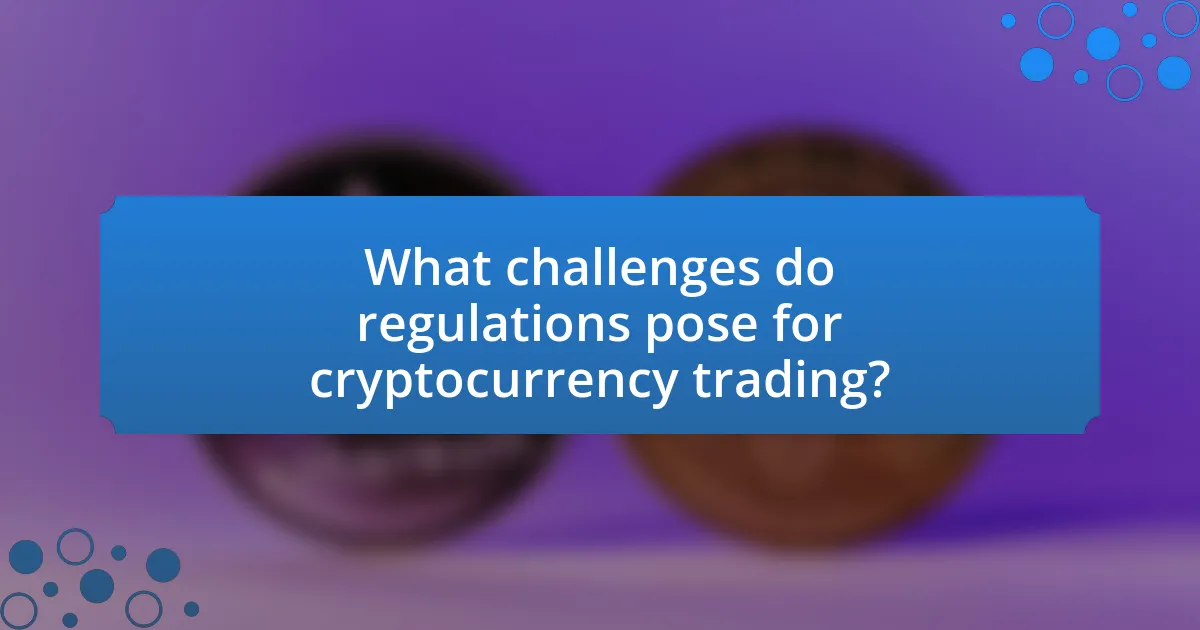The article focuses on the impact of regulations on cryptocurrency trading, highlighting key regulatory frameworks such as the Financial Action Task Force (FATF) guidelines, the European Union’s Markets in Crypto-Assets (MiCA) regulation, and U.S. Securities and Exchange Commission (SEC) regulations. It examines how different countries approach cryptocurrency regulation, the role of financial authorities and central banks, and the implications of regulations on trading practices, volumes, and investor behavior. Additionally, the article discusses the challenges faced by cryptocurrency exchanges in compliance, the effects of regulations on innovation, and best practices for traders to navigate the regulatory landscape effectively.

What are the key regulations affecting cryptocurrency trading?
Key regulations affecting cryptocurrency trading include the Financial Action Task Force (FATF) guidelines, the European Union’s Markets in Crypto-Assets (MiCA) regulation, and the U.S. Securities and Exchange Commission (SEC) regulations. The FATF guidelines require countries to implement anti-money laundering (AML) and counter-terrorism financing (CTF) measures for cryptocurrency exchanges, ensuring that they conduct customer due diligence and report suspicious activities. The MiCA regulation aims to create a comprehensive regulatory framework for digital assets within the EU, enhancing consumer protection and market integrity. The SEC regulates cryptocurrencies by classifying certain tokens as securities, which subjects them to federal securities laws, requiring registration and compliance from issuers. These regulations collectively shape the operational landscape for cryptocurrency trading, influencing compliance requirements and market practices.
How do different countries regulate cryptocurrency trading?
Different countries regulate cryptocurrency trading through a variety of frameworks that can include outright bans, strict licensing requirements, or more lenient approaches. For instance, in the United States, cryptocurrency exchanges must comply with federal regulations and state laws, requiring registration with the Financial Crimes Enforcement Network (FinCEN) and adherence to anti-money laundering (AML) practices. In contrast, countries like China have implemented a comprehensive ban on cryptocurrency trading and initial coin offerings (ICOs) to mitigate financial risks. Meanwhile, nations such as Switzerland have adopted a more favorable stance, establishing a regulatory framework that encourages innovation while ensuring consumer protection. This diversity in regulatory approaches reflects each country’s economic priorities and risk tolerance regarding cryptocurrencies.
What are the regulatory frameworks in the United States?
The regulatory frameworks in the United States encompass a variety of laws and agencies that govern financial markets, including cryptocurrency trading. Key regulatory bodies include the Securities and Exchange Commission (SEC), which oversees securities laws, and the Commodity Futures Trading Commission (CFTC), which regulates derivatives and futures markets. Additionally, the Financial Crimes Enforcement Network (FinCEN) enforces anti-money laundering (AML) regulations applicable to cryptocurrency exchanges. The Bank Secrecy Act (BSA) also plays a crucial role in compliance requirements for financial institutions dealing with cryptocurrencies. These frameworks aim to protect investors, ensure market integrity, and prevent illicit activities within the cryptocurrency space.
How does the European Union approach cryptocurrency regulations?
The European Union approaches cryptocurrency regulations through a comprehensive framework aimed at ensuring consumer protection, financial stability, and preventing illicit activities. This regulatory framework includes the Markets in Crypto-Assets (MiCA) proposal, which seeks to create a unified regulatory environment across member states, addressing issues such as transparency, market integrity, and the classification of crypto-assets. The European Commission has emphasized the need for a balanced approach that fosters innovation while mitigating risks, as evidenced by its 2020 Digital Finance Strategy, which outlines the importance of adapting existing financial regulations to encompass digital assets.
What are the regulations in Asia-Pacific countries?
Regulations in Asia-Pacific countries regarding cryptocurrency trading vary significantly, with some nations adopting strict frameworks while others maintain a more lenient approach. For instance, Japan has established a comprehensive regulatory framework under the Financial Services Agency, requiring cryptocurrency exchanges to register and comply with anti-money laundering (AML) measures. In contrast, countries like China have imposed outright bans on cryptocurrency trading and initial coin offerings (ICOs), reflecting a stringent regulatory stance. Additionally, Australia has implemented regulations that require cryptocurrency exchanges to register with the Australian Transaction Reports and Analysis Centre (AUSTRAC) and adhere to AML and counter-terrorism financing (CTF) laws. These diverse regulatory environments impact the operational landscape for cryptocurrency trading across the Asia-Pacific region, influencing market participation and investor confidence.
What role do financial authorities play in cryptocurrency regulation?
Financial authorities play a crucial role in cryptocurrency regulation by establishing legal frameworks that govern the use and trading of digital currencies. These authorities, such as the Securities and Exchange Commission (SEC) in the United States, enforce compliance with existing financial laws to protect investors and maintain market integrity. For instance, they classify certain cryptocurrencies as securities, requiring issuers to register and provide disclosures, thereby reducing the risk of fraud. Additionally, financial authorities monitor cryptocurrency exchanges to ensure they adhere to anti-money laundering (AML) and know your customer (KYC) regulations, which are essential for preventing illicit activities. This regulatory oversight aims to create a safer trading environment and foster public trust in the cryptocurrency market.
How do central banks influence cryptocurrency trading regulations?
Central banks influence cryptocurrency trading regulations primarily through the establishment of monetary policy and regulatory frameworks that govern financial markets. By issuing guidelines and directives, central banks can shape how cryptocurrencies are treated within the financial system, impacting their legality, taxation, and the requirements for exchanges and financial institutions dealing with digital assets. For instance, the European Central Bank has issued reports emphasizing the need for a regulatory approach to mitigate risks associated with cryptocurrencies, which has led to the development of the EU’s Markets in Crypto-Assets Regulation (MiCA). This regulatory framework aims to provide clarity and security for cryptocurrency operations, demonstrating how central banks can directly affect the regulatory landscape.
What is the impact of securities regulators on cryptocurrency exchanges?
Securities regulators significantly influence cryptocurrency exchanges by enforcing compliance with financial laws and regulations. This regulatory oversight aims to protect investors, ensure market integrity, and prevent fraud. For instance, the U.S. Securities and Exchange Commission (SEC) has classified certain cryptocurrencies as securities, requiring exchanges to register and adhere to specific regulatory standards. This classification impacts how exchanges operate, as they must implement Know Your Customer (KYC) and Anti-Money Laundering (AML) procedures to comply with legal requirements. Additionally, regulatory actions can lead to increased operational costs for exchanges, as they must invest in compliance infrastructure. The presence of securities regulators can also enhance consumer confidence, potentially leading to greater market participation and stability.

How do regulations impact cryptocurrency trading practices?
Regulations significantly impact cryptocurrency trading practices by establishing legal frameworks that govern market operations. These regulations can enhance market integrity, protect investors, and reduce fraud, as seen in jurisdictions like the United States, where the Securities and Exchange Commission (SEC) enforces rules to ensure transparency and compliance. For instance, the implementation of the Anti-Money Laundering (AML) and Know Your Customer (KYC) regulations requires exchanges to verify user identities, which helps mitigate illicit activities. Additionally, regulatory clarity can foster institutional investment, as firms are more likely to engage in trading when they understand the legal landscape, evidenced by the increase in institutional participation following the introduction of clearer regulations in various countries.
What are the effects of regulations on trading volumes?
Regulations significantly affect trading volumes in cryptocurrency markets by either increasing or decreasing market activity. When regulations are introduced that enhance transparency and security, such as Know Your Customer (KYC) and Anti-Money Laundering (AML) requirements, trading volumes often increase as institutional investors feel more secure entering the market. For instance, a study by the University of Cambridge found that regulatory clarity can lead to a 20% increase in trading volumes as more participants engage in compliant trading practices. Conversely, stringent regulations can lead to decreased trading volumes, as seen in countries like China, where crackdowns on cryptocurrency exchanges resulted in a sharp decline in trading activity, with volumes dropping by over 90% in some cases. Thus, the nature of regulations—whether they promote security and compliance or impose restrictions—directly influences trading volumes in the cryptocurrency market.
How do stricter regulations affect market liquidity?
Stricter regulations typically reduce market liquidity by increasing compliance costs and limiting the number of participants in the market. When regulatory frameworks become more stringent, market participants, such as exchanges and traders, face higher operational costs due to the need for enhanced reporting, monitoring, and compliance systems. For instance, a study by the Bank for International Settlements in 2020 indicated that increased regulatory scrutiny in financial markets often leads to reduced trading volumes, as smaller firms may exit the market due to the inability to meet these new requirements. Consequently, this reduction in active participants can lead to wider bid-ask spreads and decreased overall market depth, further diminishing liquidity.
What is the relationship between regulation and trading activity?
Regulation directly influences trading activity by establishing the legal framework within which trading occurs. Regulatory measures, such as compliance requirements and trading restrictions, can either facilitate or hinder market participation. For instance, stringent regulations may reduce trading volumes by increasing operational costs for traders, while clear and supportive regulations can enhance market confidence and attract more participants. Historical data from jurisdictions with well-defined regulatory frameworks, like the European Union’s MiFID II, shows increased trading activity and market stability compared to regions with ambiguous regulations.
How do regulations influence investor behavior in cryptocurrency markets?
Regulations significantly influence investor behavior in cryptocurrency markets by establishing a framework that enhances market legitimacy and reduces perceived risks. When regulatory bodies implement clear guidelines, investors are more likely to participate, as they feel protected from fraud and market manipulation. For instance, the introduction of the European Union’s Markets in Crypto-Assets (MiCA) regulation aims to create a unified regulatory approach, which can lead to increased institutional investment. A study by the Cambridge Centre for Alternative Finance indicates that regulatory clarity correlates with higher trading volumes and market stability, demonstrating that well-defined regulations can foster investor confidence and engagement in cryptocurrency markets.
What are the implications of regulations on retail investors?
Regulations significantly impact retail investors by shaping their access to cryptocurrency markets and influencing their trading behaviors. These regulations can enhance investor protection by establishing clear guidelines that reduce the risk of fraud and market manipulation, thereby fostering a safer trading environment. For instance, the implementation of Know Your Customer (KYC) and Anti-Money Laundering (AML) regulations helps ensure that retail investors engage with legitimate platforms, which can lead to increased trust in the market. However, stringent regulations may also limit the availability of certain investment opportunities and increase compliance costs for trading platforms, potentially leading to reduced market participation among retail investors. According to a report by the Financial Action Task Force (FATF), effective regulation can lead to a more stable market, which ultimately benefits retail investors by providing a more predictable trading landscape.
How do institutional investors respond to regulatory changes?
Institutional investors typically respond to regulatory changes by adjusting their investment strategies and compliance frameworks. For instance, when new regulations are introduced, these investors often reassess their risk management practices to align with the updated legal landscape. A notable example is the implementation of the European Union’s Markets in Crypto-Assets Regulation (MiCA), which prompted institutional investors to enhance their due diligence processes and reporting mechanisms to ensure compliance. This proactive approach helps mitigate potential legal risks and maintain investor confidence in the evolving cryptocurrency market.

What challenges do regulations pose for cryptocurrency trading?
Regulations pose significant challenges for cryptocurrency trading by creating compliance burdens and limiting market access. Regulatory frameworks often require exchanges and traders to adhere to strict Know Your Customer (KYC) and Anti-Money Laundering (AML) policies, which can increase operational costs and complexity. For instance, in the United States, the Financial Crimes Enforcement Network (FinCEN) mandates that cryptocurrency exchanges register as money services businesses, leading to additional regulatory scrutiny. Furthermore, varying regulations across jurisdictions can create confusion and hinder cross-border trading, as seen in the European Union’s MiFID II directive, which imposes different requirements on crypto assets compared to traditional financial instruments. These challenges can stifle innovation and deter participation in the cryptocurrency market.
What are the compliance challenges faced by cryptocurrency exchanges?
Cryptocurrency exchanges face significant compliance challenges primarily due to the rapidly evolving regulatory landscape. These challenges include adhering to Anti-Money Laundering (AML) and Know Your Customer (KYC) regulations, which require exchanges to implement robust identity verification processes to prevent illicit activities. For instance, in 2021, the Financial Action Task Force (FATF) updated its guidelines, emphasizing the need for exchanges to monitor transactions and report suspicious activities, which adds operational complexity and costs. Additionally, exchanges must navigate varying regulations across jurisdictions, leading to inconsistencies in compliance requirements. This complexity is exemplified by the differing approaches taken by the U.S. Securities and Exchange Commission (SEC) and the European Union’s Markets in Crypto-Assets (MiCA) regulation, which can create confusion and compliance risks for exchanges operating internationally.
How do exchanges navigate anti-money laundering (AML) regulations?
Exchanges navigate anti-money laundering (AML) regulations by implementing robust compliance programs that include customer due diligence, transaction monitoring, and reporting suspicious activities. These programs are designed to identify and verify the identities of users, assess risks associated with transactions, and ensure adherence to legal requirements. For instance, many exchanges utilize Know Your Customer (KYC) procedures to collect and verify user information, which helps prevent illicit activities. Additionally, they often employ advanced software to monitor transactions in real-time, allowing them to detect unusual patterns that may indicate money laundering. According to the Financial Action Task Force (FATF), compliance with AML regulations is crucial for maintaining the integrity of financial systems and preventing the misuse of cryptocurrencies for illegal purposes.
What are the implications of Know Your Customer (KYC) requirements?
Know Your Customer (KYC) requirements have significant implications for cryptocurrency trading, primarily by enhancing regulatory compliance and reducing the risk of fraud. KYC mandates that financial institutions verify the identity of their clients, which helps prevent money laundering and terrorist financing. According to a report by the Financial Action Task Force (FATF), implementing KYC measures can lead to a decrease in illicit activities within the cryptocurrency space, as it creates a more transparent environment. Furthermore, KYC compliance can increase trust among users and investors, as it demonstrates a commitment to security and regulatory standards. This, in turn, can attract institutional investors who prioritize compliance and risk management in their trading activities.
How do regulations affect innovation in the cryptocurrency space?
Regulations significantly impact innovation in the cryptocurrency space by creating a framework that can either foster or hinder development. When regulations are clear and supportive, they can encourage investment and innovation by providing legal certainty, as seen in jurisdictions like Switzerland, where favorable regulations have led to a thriving crypto ecosystem. Conversely, overly restrictive regulations can stifle innovation by increasing compliance costs and limiting market access, as evidenced by the decline in startup activity in regions with stringent regulatory environments, such as China, which has imposed heavy restrictions on cryptocurrency activities. Thus, the nature of regulations directly influences the pace and direction of innovation within the cryptocurrency sector.
What are the risks of over-regulation for blockchain technology development?
Over-regulation poses significant risks to blockchain technology development by stifling innovation and limiting market participation. Excessive regulatory measures can create barriers to entry for startups, reducing competition and hindering the growth of new ideas and solutions. For instance, a report by the World Economic Forum highlights that stringent regulations can lead to a decrease in investment in blockchain projects, as potential investors may perceive the environment as too risky or uncertain. Additionally, over-regulation can drive blockchain activities underground, making it harder for authorities to monitor and ensure compliance, ultimately undermining the intended purpose of regulation.
How do regulations impact the emergence of new cryptocurrency projects?
Regulations significantly impact the emergence of new cryptocurrency projects by establishing legal frameworks that can either facilitate or hinder their development. For instance, stringent regulations may deter innovation by imposing high compliance costs and limiting access to funding, as seen in countries like China, where strict bans on Initial Coin Offerings (ICOs) have stifled local project launches. Conversely, clear and supportive regulatory environments, such as those in Switzerland, can encourage the growth of new projects by providing legal certainty and fostering investor confidence. This duality illustrates how regulations can shape the landscape of cryptocurrency innovation, influencing both the number and viability of new projects entering the market.
What best practices should traders follow to navigate regulations effectively?
Traders should prioritize staying informed about regulatory changes to navigate regulations effectively. This involves regularly reviewing updates from regulatory bodies such as the Securities and Exchange Commission (SEC) and the Commodity Futures Trading Commission (CFTC), which provide guidelines and rules that affect trading practices. Additionally, traders should maintain comprehensive records of their transactions and communications to ensure compliance and facilitate audits. Engaging with legal experts or compliance consultants can also help traders understand complex regulations and implement necessary changes in their trading strategies. By adhering to these practices, traders can mitigate risks associated with non-compliance and enhance their operational integrity in the cryptocurrency market.
How can traders stay informed about regulatory changes?
Traders can stay informed about regulatory changes by regularly monitoring official government websites and financial regulatory authorities. These sources provide updates on new regulations, amendments, and compliance requirements relevant to trading activities. For instance, the U.S. Securities and Exchange Commission (SEC) and the Commodity Futures Trading Commission (CFTC) frequently publish press releases and guidance documents that outline regulatory changes affecting traders. Additionally, subscribing to industry newsletters and following reputable financial news outlets can help traders receive timely information on regulatory developments.
What strategies can traders employ to ensure compliance with regulations?
Traders can employ several strategies to ensure compliance with regulations, including implementing robust Know Your Customer (KYC) procedures, conducting regular audits, and utilizing compliance software. KYC procedures help verify the identity of clients, which is essential for adhering to anti-money laundering (AML) laws. Regular audits enable traders to assess their compliance status and identify any potential regulatory gaps, ensuring they remain aligned with evolving legal requirements. Additionally, compliance software can automate monitoring processes, flagging suspicious activities and generating necessary reports, thus streamlining adherence to regulations. These strategies collectively enhance a trader’s ability to operate within the legal framework, minimizing the risk of penalties or legal issues.


